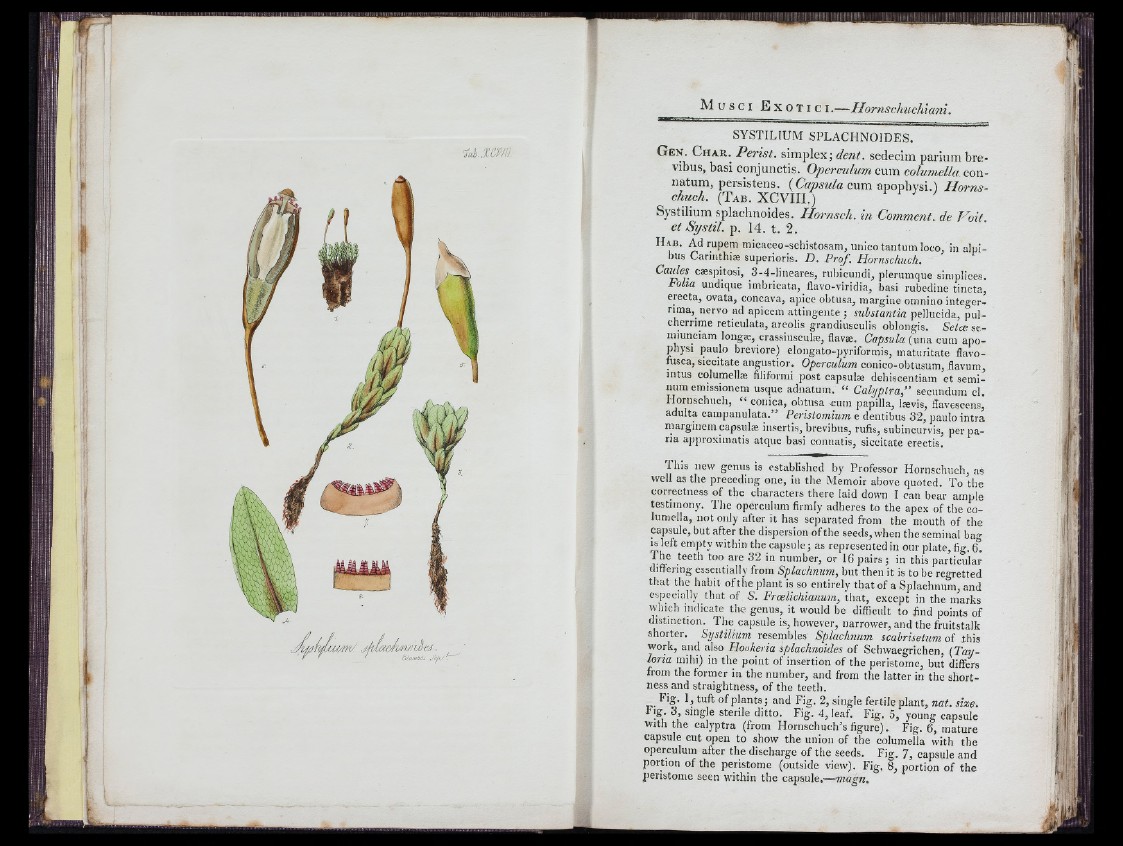
1 a i x m
SYSTILIUM SPLACHNOIDES.
Gen. C h a r . Perist. simplex; dejit. sedecim parmmbre-
vibus, basi conjunctis. Operculum c u ih columella con-
natum, persistens. {Capsula CMm apophvsi.) Horns-
chuch. (Tab. XCVIII.)
Systilium splachnoides. Hornsch. in Comment, de Voit.
et Systil. p. 14. t. 2.
IIab. Ad rupem micaceo-schistosam, unico tantum loco, in alpi-
bus Carinthiie superioris. Z). Prof, Hornschuch,
Cajdes caespitosi, 3-4-lineares, nibicundi, plerumque simplices.
lo lta undique imbiicata, flavo-viridia, basi rubedine tincta,
erecta, ovata, concava, apice obtusa, margine omnino integerrima,
nervo ad apicem attingente ; sulstantin pellucida, pul-
clierrime reticulata, areolis grandiusculis oblongis. Seia: se-
miunciam long8e,_crassiusculae, flavee. Capsula (una cum apo-
piysi paulo breviore) elongato-pyriformis, matiiritate flavo-
fusca, siccitate angustior. Operculum conico-obtusum, flavum,
intus columellae filiformi post capsulae deliiscentiam et semi-
num emissionem usque adnatum. “ Calyptra;’ secundum cl.
Iloruschuch, “ conica, obtusa x;um papilla, tevis, ffavescens,
adulta campanulata.” Perisiornium e dentibus 32, paulo intra
marginem capsuliE insertis, brevibus, rufis, subincurvis, per paria
approximatis atque basi connatis, siccitate erectis.
This new gemis is established by Professor Hornschuch, as
well as the preceding one, in the Memoir above quoted. To the
correctness of the characters there laid down I can bear ample
testimony. 'I’he operculum firmly adheres to the apex of the columella,
not only after it has separated from the mouth of the
capsule, but after the dispersion of the seeds, when the seminal ha«-
is left empty within the capsule ; as represented in our plate, fig. Q,
The teeth too are 32 in number, or 16 pairs; in this particular
differing essentially from Splachnum, but then it is to be regretted
that the habit of the plant is so entirely that of a Splachnum, and
especially that of S. Fralkhianum, that, except in the marks
which indicate the genus, it would be difficult to find points of
distinction.^ The capsule is, however, narrower, and the fruitstalk
shorter, Systilimn resembles Splachnum scahrisetum of this
work, and also Houkeria splachnoides of Schwaegrichen, {Tay-
loria mihi) in the point of insertion of the peristome, but differs
from the former in the number, and from the latter in the shortness
and straightness, of the teeth.
Fig. 1, tuft of plants ; and Fig. 2, single fertile plant, nat. size.
fig . 3, single sterile ditto. Fig. 4, leaf. Fig. 5, young capsule
with the calyptra (from Hornschuch’s figure). Fig. 6, mature
capsule cut open to show the union of the columella with the
operculum after the discharge of the seeds. Fig. 7, capsule and
portion of the peristome (outside view). Fig. 8, portion of the
peristome seen within the capsule.—magn.
j'
i I
it
1 .la
I